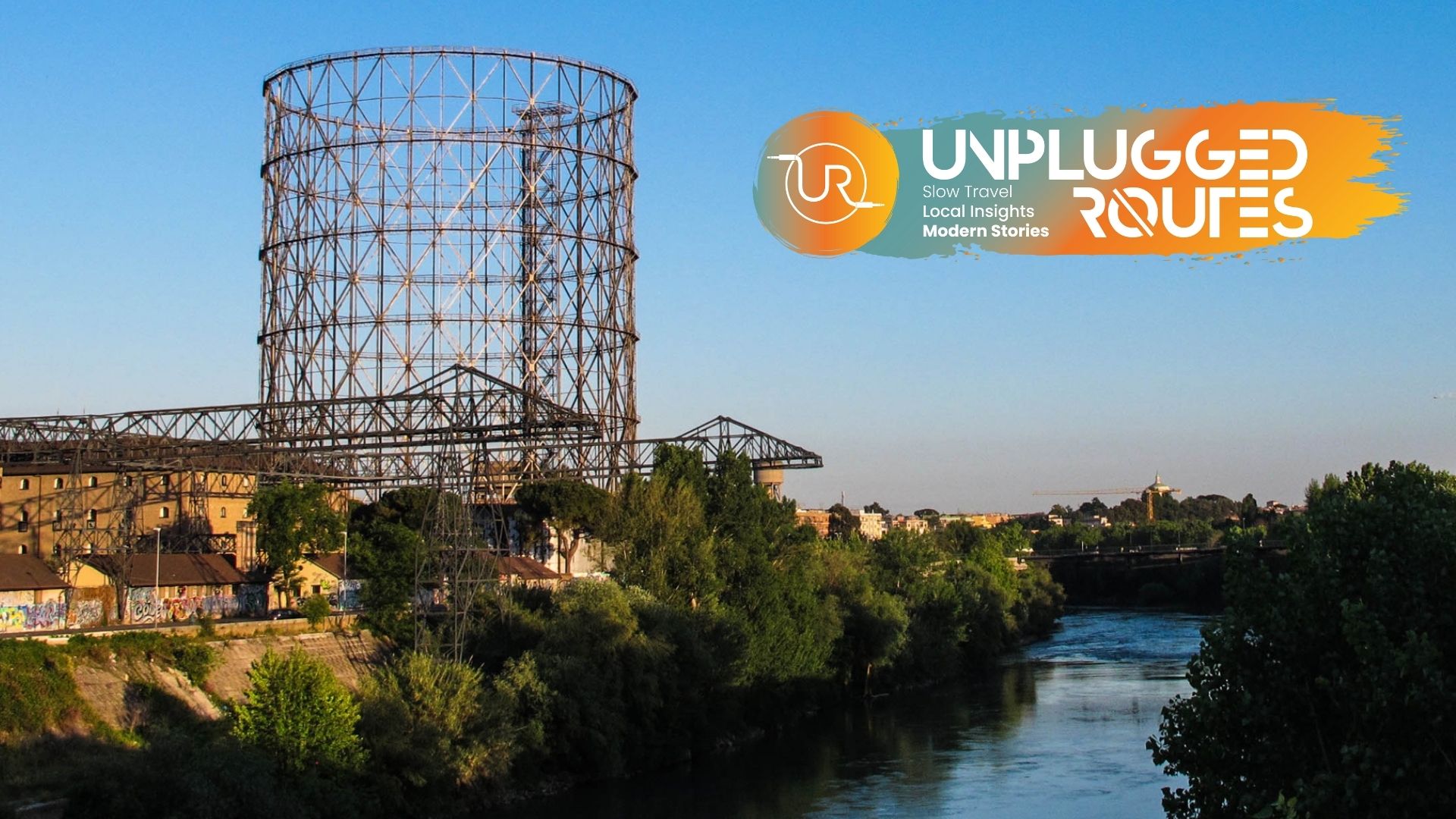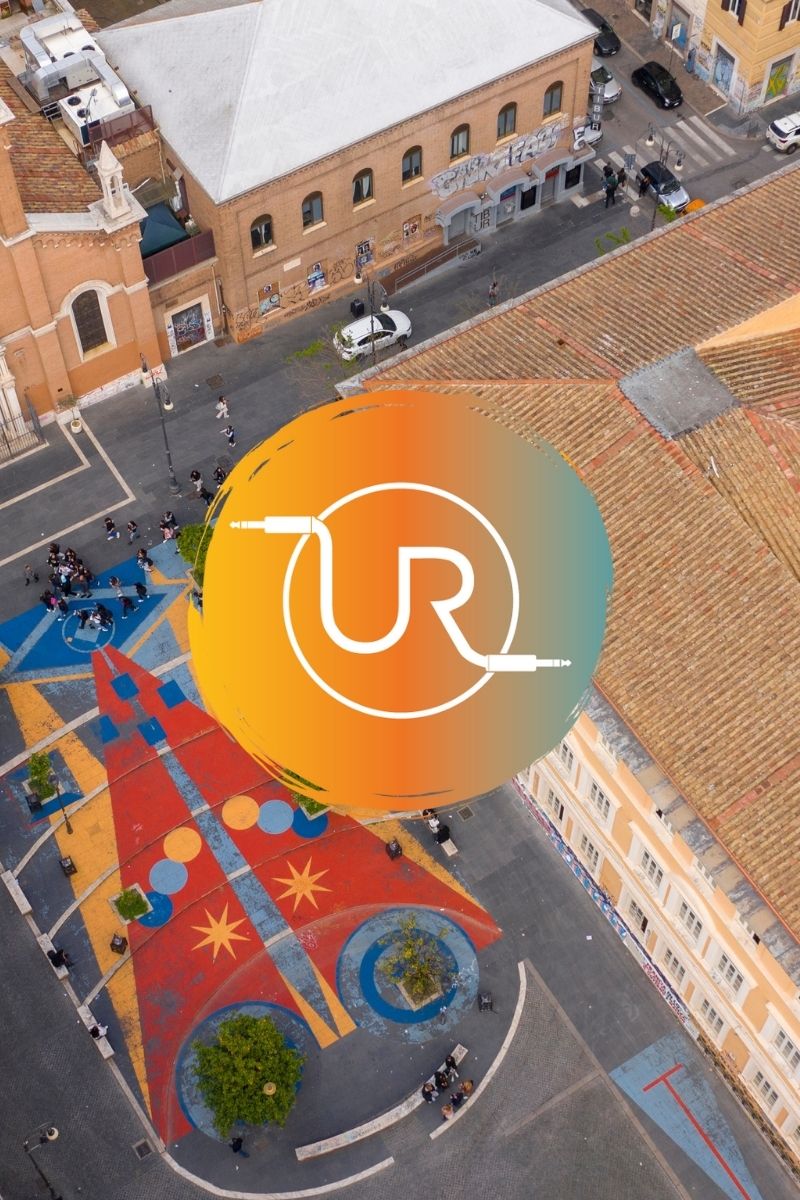
Located in the Ostiense neighborhood of Rome, the Gazometro (Gasworks) was built between 1935 and 1937. In a 1936 article published by the Fascist-era Istituto Luce, the following information was given about Rome’s largest gasworks: “Rome’s public services are developing rapidly. The largest gasworks in Italy, with a capacity of 200,000 cubic meters, is rising just beyond Porta San Paolo. Some 3,000 tons of iron were used to create the massive metal structure, and two pipelines, each weighing thousands of tons, 7 kilometers long, have been laid to deliver the gas to the most remote areas of the city. The entire gas plant was manufactured in Italy and installed by local labor. The new gas plant will be operational this fall.”
With a height of about 90 meters, a diameter of 63 meters and a gas storage capacity of 200,000 cubic meters, it is the largest gasworks in Italy and one of the largest in Europe. In its construction, 1,551 iron piles weighing a total of 3,000 tons and 36 kilometers long were used. The gasworks played a major role in meeting Rome’s energy needs, especially during World War II, by storing the gas obtained from coal and transferring it to different areas of the city.
Today, even though it has lost its function, it is preserved as part of the industrial heritage and hosts various cultural projects. On one side of Rome’s skyline is the dome of San Pietro, which has symbolized the city for centuries, and on the other side is the Gasometro, the product of the industrial revolution, also known as the “Third Colosseum”. The gasworks, whose surroundings have been transformed in recent years into an area that hosts art galleries, cultural events and innovative projects, continues to exist as a symbol of Rome’s history of modernization and industrialization, as well as its social reality.
Gazometro’s Place in Cinema History
The Gazometro has emerged as an important visual element in the cinematographic background of Rome, especially in post-World War II Italian cinema. Vittorio De Sica’s famous film “Sciuscià”(1946) contributed to the transformation of the gasworks into a symbolic structure. In the 1950s, Luchino Visconti’s “Bellissima” the gas station is often used to depict the slums of Rome. Luciano Emmer’s “Domenica d’agosto” (1950), unemployed and hopeless characters live their lives in the shadow of the Gazometro. During this period, the gasworks became a cinematographic symbol of Rome, especially for areas outside the city center.The 1961 Pier Paolo Pasolini film “Accattone”Pasolini shows the gasworks as a structure that witnesses the hopeless lives of the characters in the film and uses it as a powerful metaphor for poverty and exclusion. Indeed, the scene at the end of the film where Accattone dies in the shadow of the gasworks is one of Pasolini’s bitter criticisms of the modernization process of Rome. The scene in which Pio and Accattone, two of the characters in the film, lean against their car and talk in front of the Gazometro has become an important symbol of Rome’s unplanned urbanization and social problems.
In the 1970s, the Gazometro was frequently featured in detective films as a backdrop where both criminals and police officers met, and thus used to depict neighborhoods associated with crime. Luc Merenda starred in “Il conto è chiuso” (1976) and Maurizio Merli starring “Paura in città” (1976), in which the casino was an important visual element. Also Michele Placido’s film about the Magliana Gang, Rome’s famous criminal organization. “Romanzo Criminale” (2005), he plays an important role in scenes reflecting 1970s Rome. The scene where a car full of bombs explodes in front of the gas station is presented as an important turning point in the movie.
In 1986, Francesco Maselli’s “Storia d’amore” Gazometro is no longer just an industrial building, but a space that integrates with the life around it. In the film, Bruna is a working-class cleaner and the Gazometro is constantly visible in the background as a symbol of the turbulent life she lives. Transformed into a structure that reflects the social dynamics of Rome, the gasworks has become a representative of changing living conditions. Nanni Moretti’s “La messa è finita” (1986), the Gazometro was used as a backdrop for scenes in which the character Don Giulio wanders through the slums of Rome and gradually became the new cultural symbol of Rome.
In the late 1990s and 2000s, the Gazometro acquired new functions in Rome’s modernization process. Mario Martone’s India Theater, opened in 1999 in the former Mira Lanza factory, was a pioneering step in the cultural transformation of the area, located directly opposite the gasworks. By locating the theater in this space, Martone demonstrated how industrial heritage can evolve into an artistic and cultural rebirth. Ferzan Özpetek’s “Le fate ignoranti” (2001), the Gazometro is no longer just an industrial building, but a new symbol of the cultural life of modern Rome. In the film, the characters living in a building in the immediate vicinity of the Gazometro represent the meeting point of Rome’s new multicultural lifestyle and the community that has formed around it. Özpetek uses the night landscapes and industrial aesthetics of the Gazometro as a cinematographically impressive backdrop, imbuing the building with deep meaning, which becomes a powerful aesthetic element that reinforces the complex emotional states of the characters.
Gazometro today
Since the early 2000s, the Gazometro has become a symbol not only of the industrial past, but also of modern Rome with its architecture and aesthetics, and has been re-evaluated as part of the city’s transformation process. This is because the new millennium has broadened the understanding of beauty, and modern industrial buildings that were considered “ugly” in the past have been re-evaluated aesthetically and artistically. This postmodern perspective has come to see gasworks and similar structures not only as physical entities, but also to include the labor involved in their construction, the personal stories and struggles of the people who worked on them, and the social conditions of those who lived nearby. In this way, the Gazometro has retained its important place in Rome’s industrial history, while at the same time taking on a new meaning as a symbol of the social and cultural changes the city has undergone with the modernization process. Although its function has changed over time, this gigantic structure continues to exist as a powerful symbol in both cinema and urban culture.
In the shadow of the gas station, which is frequently featured in the thematic routes prepared for you by Unplugged Routes, you will breathe in the unique life of the Ostiense and Testaccio neighborhoods and spend an extraordinary day in Rome full of street art, crime gangs and cinema stories.







Leave a comment: